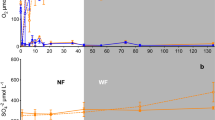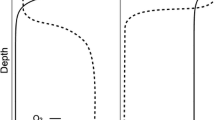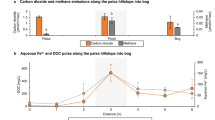Abstract
Iron (Fe) plays a key role in elemental cycling at terrestrial–aquatic interfaces by stabilizing carbon (C), phosphorus (P), and nutrient cations through physicochemical associations and by potentially releasing these elements following the reduction of Fe(III) to Fe(II). However, the ecosystem-scale importance of Fe redox cycling and its responses to climate change remain unclear in precipitation-fed peatlands (bogs), C-rich wetlands with very low mineral content. We tested impacts of Fe redox cycling on C and nutrient release in two bogs in northern Minnesota and in Spruce and Peatland Responses Under Changing Environments (SPRUCE), an ecosystem-scale warming experiment. Concentrations of Fe(III) declined from the peat surface to 50 cm depth (31 to 0.5 µmol g−1) and co-occurred with Fe(II) (10 to 30 µmol g−1). Chemical reduction of Fe(III) released C and P from variably saturated (0–30 cm) peat (106–1006 µmol C g−1; 0.6–5 µmol P g−1), and Fe-bound C was similar to previous measurements from upland mineral soils. Concentrations of Fe(II) and dissolved organic carbon (DOC) were strongly (R2 = 0.56–0.78) and positively correlated in water samples measured at SPRUCE enclosure outlets and ambient near-surface porewater. Concentrations of Fe(II) also correlated positively with P at warmer SPRUCE temperature treatments and increased with experimental warming, but stabilized at the highest temperature treatments as water depth declined. Although bogs have low total mineral content, mass balance measurements indicated that atmospheric deposition could in principle sustain significant Fe cycling and hydrologic losses in these ecosystems. Overall, Fe redox cycling significantly impacted C and nutrient dynamics in these mineral-poor bogs, contributing to strong correlations between Fe(II) and DOC in water samples. Increased Fe(III) reduction with warmer temperatures will likely promote peatland C and nutrient release, impacting ecosystem C budgets both directly and indirectly by enhancing decomposition and productivity.






Similar content being viewed by others
References
Björnerås C, Weyhenmeyer GA, Evans CD, Gessner MO, Grossart H-P, Kangur K, Kokorite I, Kortelainen P, Laudon H, Lehtoranta J, Lottig N, Monteith DT, Nõges P, Nõges T, Oulehle F, Riise G, Rusak JA, Räike A, Sire J, Sterling S, Kritzberg ES. 2017. Widespread increases in iron concentration in European and North American freshwaters. Glob Biogeochem Cycles 31:1488–1500.
Blazevic A, Orlowska E, Kandioller W, Jirsa F, Keppler BK, Tafili-Kryeziu M, Linert W, Krachler RF, Krachler R, Rompel A. 2016. Photoreduction of terrigenous Fe-humic substances leads to bioavailable iron in oceans. Angew Chem 128:6527–6532.
Blodau C, Roehm CL, Moore TR. 2002. Iron, sulfur, and dissolved carbon dynamics in a northern peatland. Arch Hydrobiol 154(4):561–583.
Bridgham SD, Pastor J, Janssens JA, Chapin C, Malterer TJ. 1996. Multiple limiting gradients in peatlands: a call for a new paradigm. Wetlands 16:45–65.
Chacon N, Silver WL, Dubinsky EA, Cusack DF. 2006. Iron reduction and soil phosphorus solubilization in humid tropical forests soils: the roles of labile carbon pools and an electron shuttle compound. Biogeochemistry 78:67–84.
Chen J, Gu B, Royer RA, Burgos WD. 2003. The roles of natural organic matter in chemical and microbial reduction of ferric iron. Sci Total Environ 307:167–178.
Chen C, Meile C, Wilmoth J, Barcellos D, Thompson A. 2018. Influence of pO2 on iron redox cycling and anaerobic organic carbon mineralization in a humid tropical forest soil. Environ Sci Technol 52:7709–7719.
Chen C, Hall SJ, Coward E, Thompson A. 2020. Iron-mediated organic matter decomposition in humid soils can counteract protection. Nat Commun 11:1–13.
Chin Y-P, Traina SJ, Swank CR, Backhus D. 1998. Abundance and properties of dissolved organic matter in pore waters of a freshwater wetland. Limnol Oceanogr 43:1287–1296.
Curtinrich HJ, Hall SJ, Sebestyen SD. 2021. Marcell Experimental Forest peat core extraction chemical analysis data (DOC, Fe, Ca, Mg, K, P, Al) ver 1. Environmental Data Initiative. https://doi.org/10.6073/pasta/8c2c908fec929b5fd812851ef9150301
Daugherty EE, Gilbert B, Nico PS, Borch T. 2017. Complexation and redox buffering of iron(II) by dissolved organic matter. Environ Sci Technol 51:11096–11104.
Dinsmore KJ, Billett MF, Skiba UM, Rees RM, Drewer J, Helfter C. 2010. Role of the aquatic pathway in the carbon and greenhouse gas budgets of a peatland catchment. Glob Change Biol 16:2750–2762.
Eisenreich SJ, Hollod GJ, Langevin S. 1978. Precipitation chemistry and atmospheric deposition of trace elements in Northeastern Minnesota. Minneapolis, MN: Environmental Engineering Program, Dept. of Civil and Mineral Engineering, University of Minnesota.
Ekström SM, Regnell O, Reader HE, Nilsson PA, Löfgren S, Kritzberg ES. 2016. Increasing concentrations of iron in surface waters as a consequence of reducing conditions in the catchment area. J Geophys Res Biogeosci 121:479–493.
Freeman C, Evans CD, Monteith DT, Reynolds B, Fenner N. 2001. Export of organic carbon from peat soils. Nature 412:785–785.
Gaffney JW, White KN, Boult S. 2008. Oxidation state and size of Fe controlled by organic matter in natural waters. Environ Sci Technol 42:3575–3581.
Griffiths NA, Sebestyen SD. 2016. Dynamic vertical profiles of peat porewater chemistry in a northern peatland. Wetlands 36:1119–1130.
Griffiths NA, Hanson PJ, Ricciuto DM, Iversen CM, Jensen AM, Malhotra A, McFarlane KJ, Norby RJ, Sargsyan K, Sebestyen SD, Shi X, Walker AP, Ward EJ, Warren JM, Weston DJ. 2017. Temporal and spatial variation in peatland carbon cycling and implications for interpreting responses of an ecosystem-scale warming experiment. Soil Sci Soc Am J 81:1668–1688.
Griffiths NA, Sebestyen SD, Oleheiser KC. 2019. Variation in peatland porewater chemistry over time and space along a bog to fen gradient. Sci Total Environ 697:134152.
Grybos M, Davranche M, Gruau G, Petitjean P, Pédrot M. 2009. Increasing pH drives organic matter solubilization from wetland soils under reducing conditions. Geoderma 154:13–19.
Hagedorn F, Kaiser K, Feyen H, Schleppi P. 2000. Effects of redox conditions and flow processes on the mobility of dissolved organic carbon and nitrogen in a forest soil. J Environ Qual 29:288–297.
Hall SJ, Huang W. 2017. Iron reduction: a mechanism for dynamic cycling of occluded cations in tropical forest soils? Biogeochemistry 136:91–102.
Hall SJ, Treffkorn J, Silver WL. 2014. Breaking the enzymatic latch: impacts of reducing conditions on hydrolytic enzyme activity in tropical forest soils. Ecology 95:2964–2973.
Hanson P, Riggs J, Nettles W, Krassovski M, Hook L. 2016. SPRUCE whole ecosystems warming (WEW) environmental data beginning August 2015. Oak Ridge, TN: Oak Ridge Natl Lab, TES SFA, US Dept Energy. https://doi.org/10.3334/CDIAC/spruce.032
Hanson PJ, Riggs JS, Nettles WR, Phillips JR, Krassovski MB, Hook LA, Gu L, Richardson AD, Aubrecht DM, Ricciuto DM, Warren JM, Barbier C. 2017. Attaining whole-ecosystem warming using air and deep-soil heating methods with an elevated CO2 atmosphere. Biogeosciences 14:861–883.
Hanson PJ, Griffiths NA, Iversen CM, Norby RJ, Sebestyen SD, Phillips JR, Chanton JP, Kolka RK, Malhotra A, Oleheiser KC, Warren JM, Shi X, Yang X, Mao J, Ricciuto DM. 2020a. Rapid net carbon loss from a whole-ecosystem warmed peatland. AGU Adv 1:e2020AV000163.
Hanson PJ, Phillips JR, Nettles WR, Pearson KJ, Hook LA. 2020b. SPRUCE plot-level water table data assessments for absolute elevations and height with respect to mean hollows beginning in 2015. Oak Ridge, TN: Oak Ridge Natl Lab, TES SFA, US Dept Energy. https://doi.org/10.25581/spruce.079/1608615.
Herndon EM, Kinsman-Costello L, Duroe KA, Mills J, Kane ES, Sebestyen SD, Thompson AA, Wullschleger SD. 2019. Iron (oxyhydr)oxides serve as phosphate traps in tundra and boreal peat soils. J Geophys Res Biogeosci 124:227–246.
Hill BH, Elonen CM, Jicha TM, Kolka RK, Lehto LLP, Sebestyen SD, Seifert-Monson LR. 2014. Ecoenzymatic stoichiometry and microbial processing of organic matter in northern bogs and fens reveals a common P-limitation between peatland types. Biogeochemistry 120:203–224.
Hopple AM, Wilson RM, Kolton M, Zalman CA, Chanton JP, Kostka J, Hanson PJ, Keller JK, Bridgham SD. 2020. Massive peatland carbon banks vulnerable to rising temperatures. Nat Commun 11:2373.
Huang W, Hall SJ. 2017b. Optimized high-throughput methods for quantifying iron biogeochemical dynamics in soil. Geoderma 306:67–72.
Huang W, Hall SJ. 2017a. Elevated moisture stimulates carbon loss from mineral soils by releasing protected organic matter. Nat Commun 8:1774.
Iversen C, Hanson P, Brice D, Phillips J, McFarlane K, Hobbie E, Kolka R. 2014. SPRUCE peat physical and chemical characteristics from experimental plot cores, 2012. Oak Ridge, TN: Oak Ridge Natl Lab, TES SFA, US Dept Energy. https://doi.org/10.3334/CDIAC/spruce.005
Keller JK, Bridgham SD. 2007. Pathways of anaerobic carbon cycling across an ombrotrophic-minerotrophic peatland gradient. Limnol Oceanogr 52:96–107.
Keller JK, Takagi KK. 2013. Solid-phase organic matter reduction regulates anaerobic decomposition in bog soil. Ecosphere 4:art54.
Kleber M, Eusterhues K, Keiluweit M, Mikutta C, Mikutta R, Nico PS. 2015. Mineral–organic associations: formation, properties, and relevance in soil environments. Adv Agron 130:1–140.
Knorr K-H. 2013. DOC-dynamics in a small headwater catchment as driven by redox fluctuations and hydrological flow paths—are DOC exports mediated by iron reduction/oxidation cycles? Biogeosciences 10:891–904.
Koehler A-K, Sottocornola M, Kiely G. 2011. How strong is the current carbon sequestration of an Atlantic blanket bog? Glob Change Biol 17:309–319.
Kolka RK, Sebestyen SD, Verry ES, Brooks KN, Eds. 2011. Peatland biogeochemistry and watershed hydrology at the Marcell Experimental Forest. Boca Raton, FL: CRC Press.
Küsel K, Blöthe M, Schulz D, Reiche M, Drake HL. 2008. Microbial reduction of iron and porewater biogeochemistry in acidic peatlands. Biogeosciences 5:1537–1549.
Lovley DR, Phillips EJP. 1987. Rapid assay for microbially reducible ferric iron in aquatic sediments. Appl Environ Microbiol 53:1536–1540.
McKnight DM, Bencala KE. 1990. The chemistry of iron, aluminum, and dissolved organic material in three acidic, metal-enriched, mountain streams, as controlled by watershed and in-stream processes. Water Resour Res 26:3087–3100.
Meier J, Costa R, Smalla K, Boehrer B, Wendt-Potthoff K. 2005. Temperature dependence of Fe(III) and sulfate reduction rates and its effect on growth and composition of bacterial enrichments from an acidic pit lake neutralization experiment. Geobiology 3:261–274.
Neal C, Lofts S, Evans CD, Reynolds B, Tipping E, Neal M. 2008. Increasing iron concentrations in UK upland waters. Aquat Geochem 14:263–288.
Nilsson M, Sagerfors J, Buffam I, Laudon H, Eriksson T, Grelle A, Klemedtsson L, Weslien P, Lindroth A. 2008. Contemporary carbon accumulation in a boreal oligotrophic minerogenic mire—a significant sink after accounting for all C-fluxes. Glob Change Biol 14:2317–2332.
Oni SK, Futter MN, Bishop K, Köhler SJ, Ottosson-Löfvenius M, Laudon H. 2013. Long-term patterns in dissolved organic carbon, major elements and trace metals in boreal headwater catchments: trends, mechanisms and heterogeneity. Biogeosciences 10:2315–2330.
Pan W, Kan J, Inamdar S, Chen C, Sparks D. 2016. Dissimilatory microbial iron reduction release DOC (dissolved organic carbon) from carbon-ferrihydrite association. Soil Biol Biochem 103:232–240.
Phillips JR, Brice DJ, Hanson PJ, Childs J, Iversen CM, Norby RJ, Warren JM. 2017. SPRUCE pretreatment plant tissue analyses, 2009 through 2013. Oak Ridge, TN: Oak Ridge Natl Lab, TES SFA, US Dept Energy. https://doi.org/10.3334/CDIAC/spruce.038
Riedel T, Zak D, Biester H, Dittmar T. 2013. Iron traps terrestrially derived dissolved organic matter at redox interfaces. Proc Natl Acad Sci 110:10101–10105.
Riedel T, Iden S, Geilich J, Wiedner K, Durner W, Biester H. 2014. Changes in the molecular composition of organic matter leached from an agricultural topsoil following addition of biomass-derived black carbon (biochar). Org Geochem 69:52–60.
Roulet NT, Lafleur PM, Richard PJH, Moore TR, Humphreys ER, Bubier J. 2007. Contemporary carbon balance and late Holocene carbon accumulation in a northern peatland. Glob Change Biol 13:397–411.
Schilling K, Borch T, Rhoades CC, Pallud CE. 2019. Temperature sensitivity of microbial Fe(III) reduction kinetics in subalpine wetland soils. Biogeochemistry 142:19–35.
Sebestyen SD, Griffiths NA. 2016. SPRUCE enclosure corral and sump system: description, operation, and calibration. Oak Ridge, TN: Clim Change Sci Inst Oak Ridge Natl Lab US Dept Energy. https://doi.org/10.3334/CDIAC/spruce.030
Sebestyen SD, Verry ES, Brooks KN. 2011b. Hydrological responses to changes in forest cover on uplands and peatlands. In: Kolka RK, Sebesteyen SD, Verry ES, Brooks KN, Eds. Peatland biogeochemistry and watershed hydrology at the Marcell Experimental Forest, . Boca Raton, FL: CRC Press. pp 401–432.
Sebestyen SD, Dorrance C, Olson D, Verry ES, Kolka RK, Elling AE, Kyllander R. 2011a. Long-term monitoring sites and trends at the Marcell Experimental Forest. In: Kolka RK, Sebestyen SD, Verry ES, Brooks K, Eds. Peatland biogeochemistry and watershed hydrology at the Marcell Experimental Forest, . Boca Raton, FL: CRC Press. pp 15–71.
Sebestyen SD, Funke MM, Cotner JB, Larson JT, Aspelin NA. 2020a. Water chemistry data for studies of the biodegradability of dissolved organic matter in peatland catchments at the Marcell Experimental Forest: 2009–2011. Fort Collins CO: Forest Service Research Data Archive. Updated 16 May 2020. https://doi.org/10.2737/RDS-2017-0067
Sebestyen SD, Oleheiser KC, Larson JT, Aspelin NA, Stelling JM, Griffiths NA, Lany NK. 2020b. Marcell Experimental Forest event based precipitation chemistry, 2008—ongoing. https://portal.edirepository.org/nis/mapbrowse?packageid=edi.609.1. Last accessed 05/03/2021
Sebestyen SD, Verry ES, Elling AE, Kyllander RL, Roman DT, Burdick JM, Lany NK, Kolka RK. 2020c. Marcell Experimental Forest daily precipitation, 1961—ongoing. https://portal.edirepository.org/nis/mapbrowse?packageid=edi.563.1. Last accessed 05/03/2021
Sebestyen SD, Funke M, Cotner JB. 2021a. Sources and biodegradability of dissolved organic matter in two headwater peatland catchments at the Marcell Experimental Forest, northern Minnesota, USA. Hydrol Process 35:e14049.
Sebestyen SD, Lany NK, Roman DT, Burdick JM, Kyllander RL, Verry ES, Kolka RK. 2021b. Hydrological and meteorological data from research catchments at the Marcell Experimental Forest. Hydrol Process. https://doi.org/10.1002/hyp.14092. In Press.
Sebestyen SD, Lany NK, Larson JT, Aspelin NA, Oleheiser KC, Nelson DK, Hall SJ, Curtinrich HJ. 2021c. Marcell Experimental Forest porewater chemistry at the S2 catchment, 2009—ongoing ver 2. Environmental Data Initiative. https://doi.org/10.6073/pasta/d7d5a29015ede8f226166064bc41cb87.
Sebestyen SD, Griffiths NA, Oleheiser KC, Stelling JM, Pierce CE, Nater EA, Wilson RM, Chanton JP, Hall SJ, Curtinrich HJ, Toner BM, Kolka RK. 2021d. SPRUCE outflow chemistry data for experimental plots beginning in 2016. Oak Ridge National Laboratory, TES SFA, U.S. Department of Energy, Oak Ridge, Tennessee, U.S.A. https://doi.org/10.25581/spruce.088/1775142.
Senesi N, Griffith SM, Schnitzer M, Townsend MG. 1977. Binding of Fe3+ by humic materials. Geochim Cosmochim Acta 41:969–976.
Shi X, Thornton PE, Ricciuto DM, Hanson PJ, Mao J, Sebestyen SD, Griffiths NA, Bisht G. 2015. Representing northern peatland microtopography and hydrology within the Community Land Model. Biogeosciences 12:6463–6477.
Tfaily MM, Wilson RM, Cooper WT, Kostka JE, Hanson P, Chanton JP. 2018. Vertical stratification of peat pore water dissolved organic matter composition in a peat bog in Northern Minnesota. J Geophys Res Biogeosci 123:479–494.
Theis TL, Singer PC. 1974. Complexation of iron(II) by organic matter and its effect on iron(II) oxygenation. Environ Sci Technol 8:569–573.
Thompson A, Chadwick OA, Boman S, Chorover J. 2006. Colloid mobilization during soil iron redox oscillations. Environ Sci Technol 40:5743–5749.
Urban NR, Eisenreich SJ, Gorham E. 1987. Aluminum, iron, zinc, and lead in bog waters of northeastern North America. Can J Fish Aquat Sci 44:1165–1172.
Urban N, Verry ES, Eisenreich S, Grigal D, Sebestyen S. 2011. Element cycling in upland/peatland watersheds. In: Kolka RK, Sebestyen SD, Verry ES, Brooks KN, Eds. Peatland biogeochemistry and watershed hydrology at the Marcell Experimental Forest, . Boca Raton, FL: CRC Press. pp 213–241.
Verry ES. 1975. Streamflow chemistry and nutrient yields from upland-peatland watersheds in Minnesota. Ecology 56:1149–1157.
Verry ES, Janssens J. 2011. Geology, vegetation, and hydrology of the S2 bog at the MEF: 12,000 years in Northern Minnesota. In: Kolka RK, Sebesteyen SD, Verry ES, Brooks KN, Eds. Peatland biogeochemistry and watershed hydrology at the Marcell Experimental Forest, . Boca Raton, FL: CRC Press. pp 93–134.
Verry ES, Brooks KN, Nichols DS, Ferris DR, Sebestyen SD. 2011. Watershed hydrology. In: Kolka RK, Sebestyen SD, Verry ES, Brooks KN, Eds. Peatland biogeochemistry and watershed hydrology at the Marcell Experimental Forest, . Boca Raton, FL: CRC Press. pp 193–212.
von der Heyden BP, Hauser EJ, Mishra B, Martinez GA, Bowie AR, Tyliszczak T, Mtshali TN, Roychoudhury AN, Myneni SCB. 2014. Ubiquitous presence of Fe(II) in aquatic colloids and its association with organic carbon. Environ Sci Technol Lett 1:387–392.
Wagai R, Mayer LM. 2007. Sorptive stabilization of organic matter in soils by hydrous iron oxides. Geochim Cosmochim Acta 71:25–35.
Weyhenmeyer GA, Prairie YT, Tranvik LJ. 2014. Browning of boreal freshwaters coupled to carbon-iron interactions along the aquatic continuum. Iwata T, editor. PLoS ONE 9:e88104.
Wood S. 2006. Generalized additive models: an introduction with R/Simon N. Wood. Boca Raton, FL: Chapman & Hall/CRC.
Yao H, Conrad R. 2000. Effect of temperature on reduction of iron and production of carbon dioxide and methane in anoxic wetland rice soils. Biol Fertil Soils 32:135–141.
Zhao Q, Poulson SR, Obrist D, Sumaila S, Dynes JJ, McBeth JM, Yang Y. 2016. Iron-bound organic carbon in forest soils: quantification and characterization. Biogeosciences 13:4777–4788.
Acknowledgements
We thank two anonymous reviewers and Keith Oleheiser, Anne Gapinski, Anthony Mirabito, and Toni Sleugh for assistance. This paper leverages several publicly available datasets cited in the text. This research was supported in part by startup funds to SJH from Iowa State University. NAG was supported by the U.S. Department of Energy (DOE), Office of Science, Office of Biological and Environmental Research. Oak Ridge National Laboratory (ORNL) is managed by UT-Battelle, LLC, for the U.S. Department of Energy under contract DE-AC05-00OR22725. The U.S. DOE SPRUCE was constructed and is operated by ORNL. SPRUCE research is a collaborative effort between ORNL and the USDA Forest Service. The participation of SDS in SPRUCE efforts, monitoring data from the MEF, sampling, and associated water chemistry analyses were funded by the Northern Research Station of the USDA Forest Service.
Author information
Authors and Affiliations
Corresponding author
Supplementary Information
Below is the link to the electronic supplementary material.
Rights and permissions
About this article
Cite this article
Curtinrich, H.J., Sebestyen, S.D., Griffiths, N.A. et al. Warming Stimulates Iron-Mediated Carbon and Nutrient Cycling in Mineral-Poor Peatlands. Ecosystems 25, 44–60 (2022). https://doi.org/10.1007/s10021-021-00639-3
Received:
Accepted:
Published:
Issue Date:
DOI: https://doi.org/10.1007/s10021-021-00639-3




